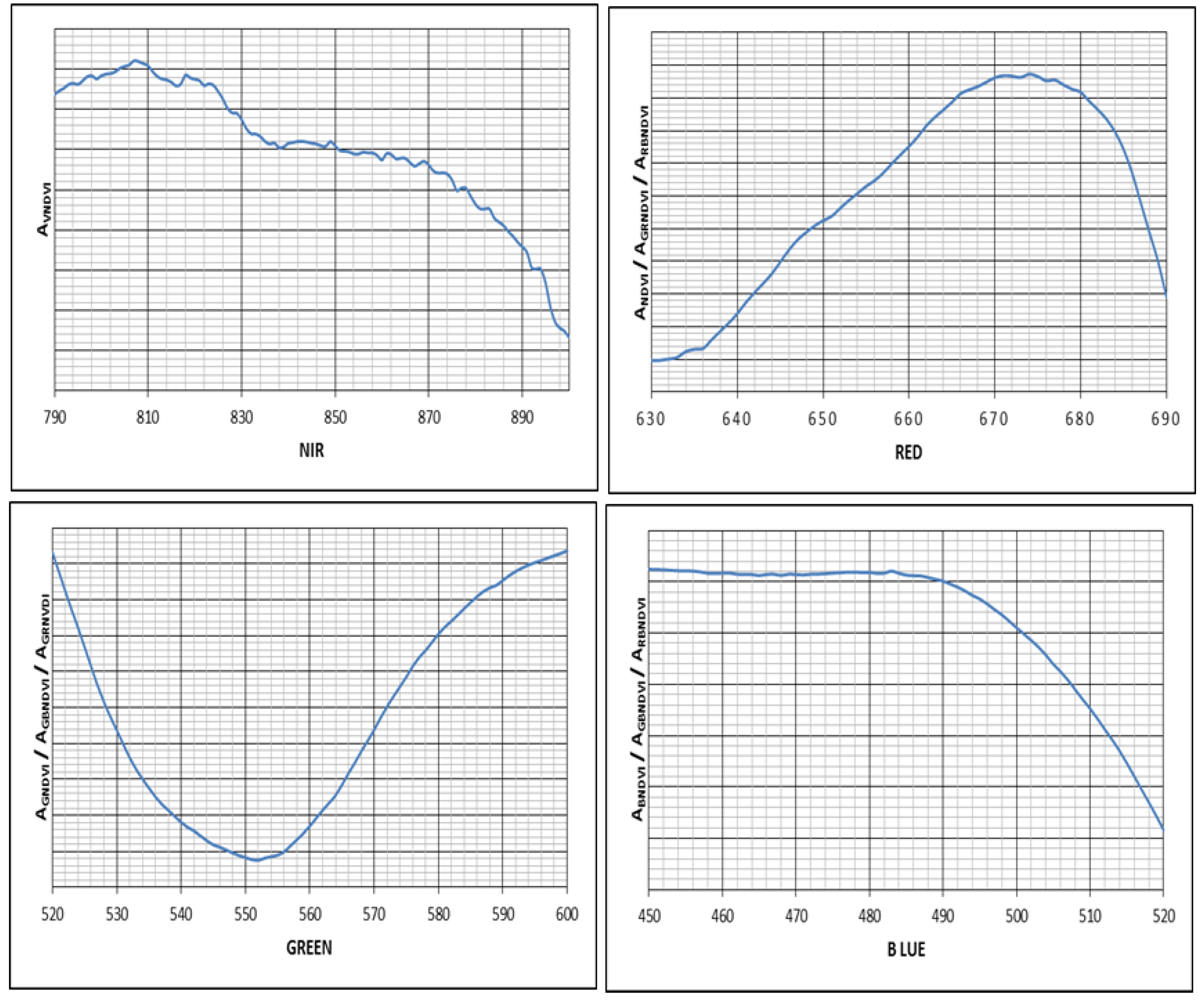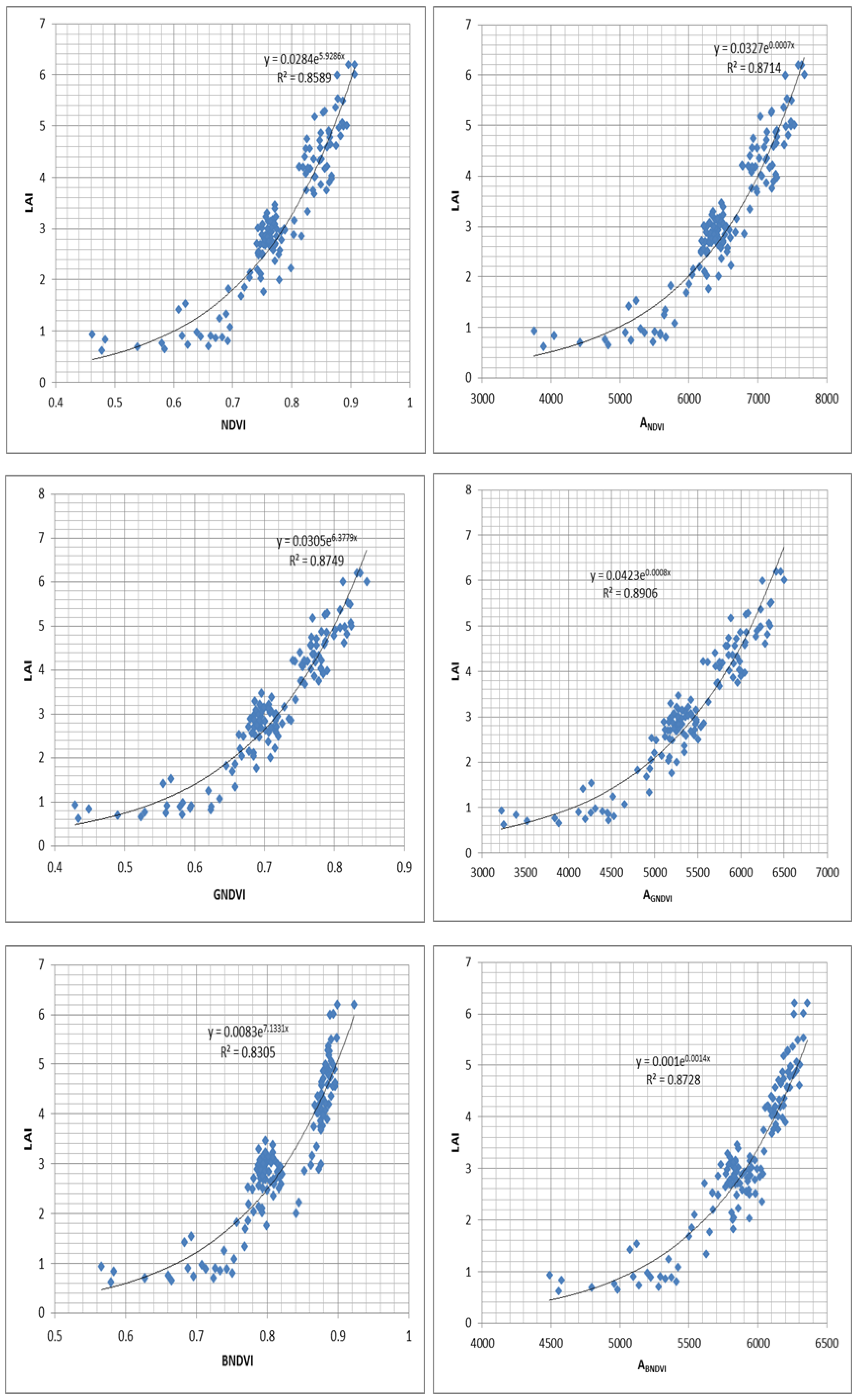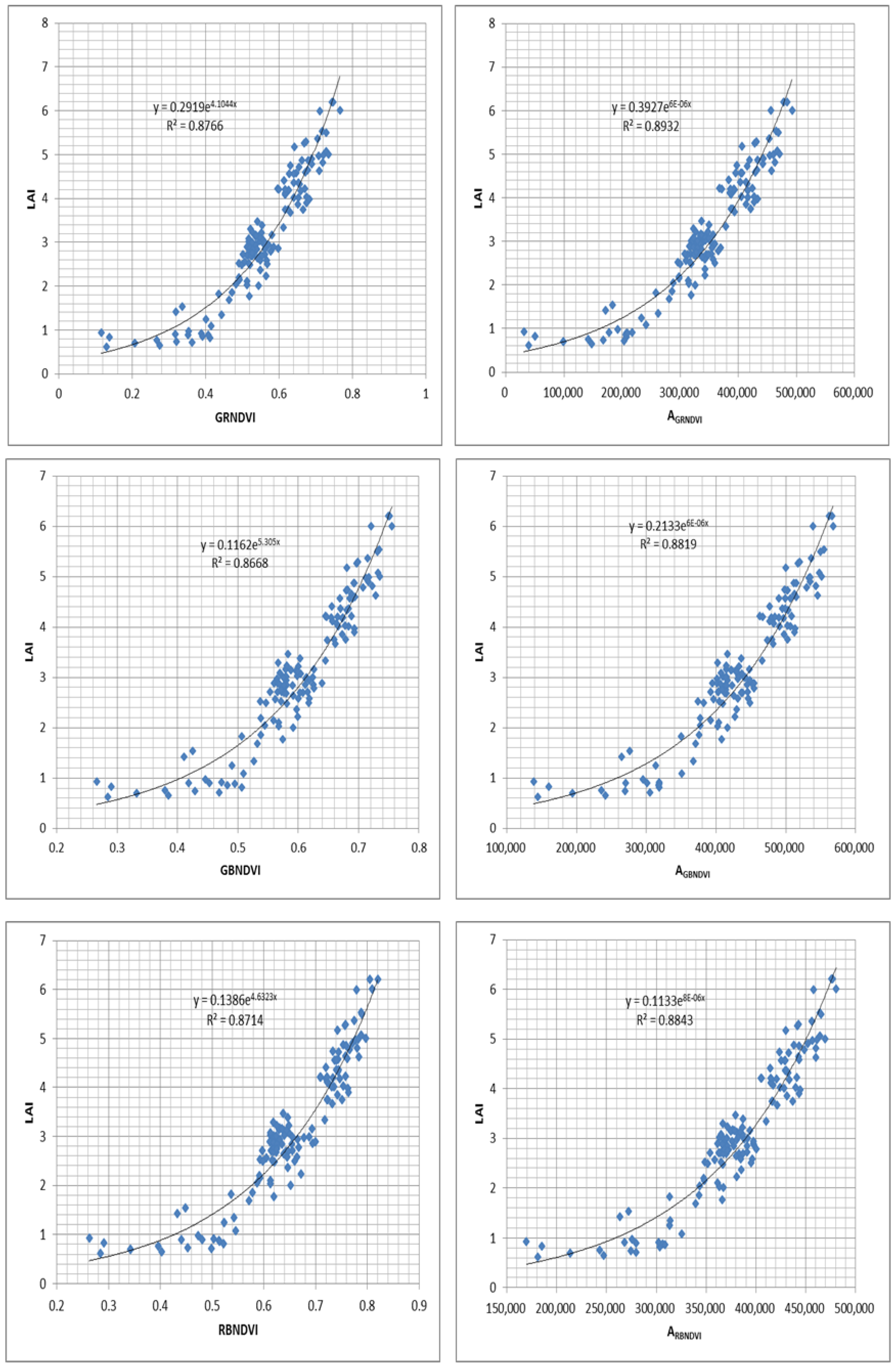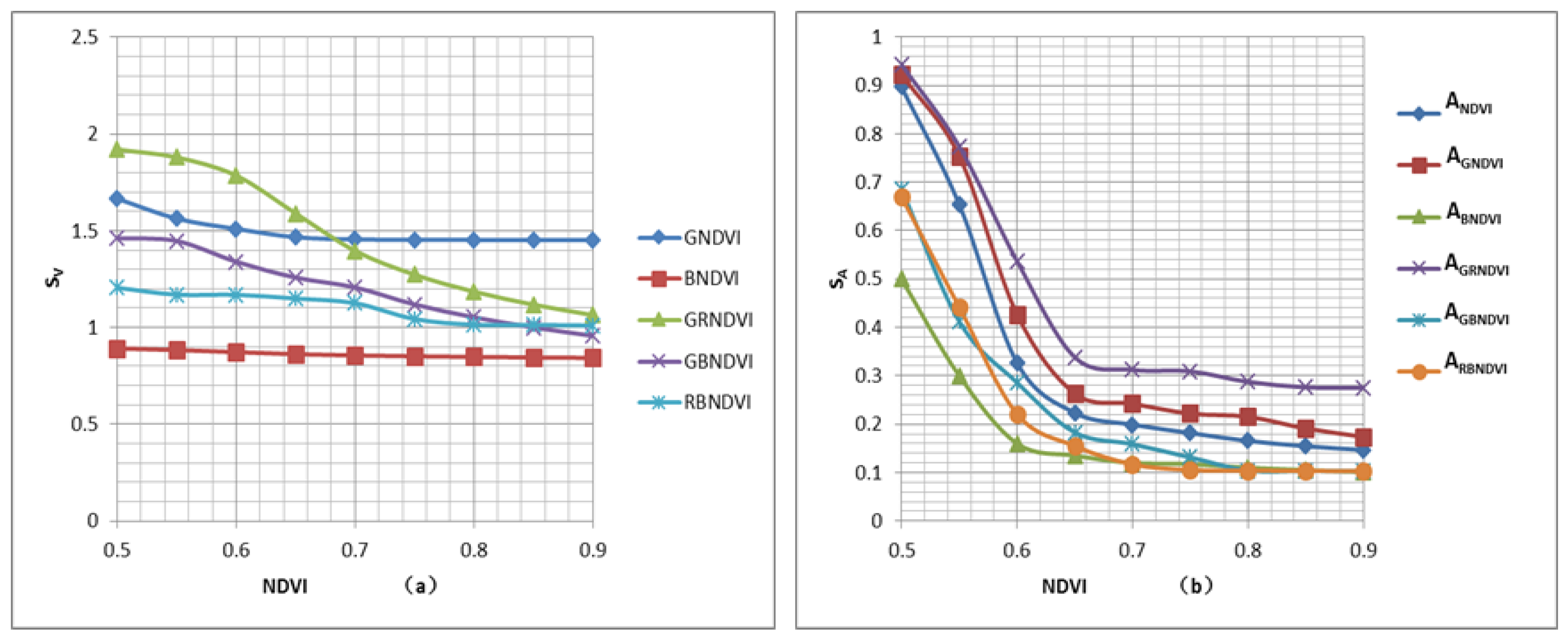Derivative Parameters of Hyperspectral NDVI and Its Application in the Inversion of Rapeseed Leaf Area Index
Abstract
:1. Introduction
2. Materials and Methods
2.1. Experimental Design
2.2. Data Collection
2.3. NDVI and Its Derivative Parameters
2.4. Measurements of Sensitivity and Anti-Interference
3. Results
3.1. Correlation Analysis of NDVI and Its Derivative Parameters
3.2. Selection of Sensitive Band
3.3. Model and Validation
3.3.1. LAI Inversion Model Based on NDVI and Its Derivative Parameters
3.3.2. Validation of LAI Inversion Model Based on the Derivative Parameters of NDVI
3.3.3. Sensitivity and Anti-Interference Analysis of NDVI and Its Derivative Parameters
4. Discussion
Author Contributions
Funding
Conflicts of Interest
References
- Chen, Z.; Xu, X.; Xu, L.; Yang, G.; Xing, H.; He, P. Estimating vegetation coverage of winter wheat based on new vegetation index. J. Triticeae Crop. 2016, 36, 939–944. [Google Scholar]
- Jin, X.L.; Xu, X.G.; Li, Z.H.; Wang, Q.; Wang, Y.; Li, C.J.; Wang, J.H. Estimation of winter wheat protein content based on new indexes. Spectrosc. Spectr. Anal. 2013, 33, 2541–2545. [Google Scholar]
- Wang, F.M.; Huang, J.F.; Tang, Y.L.; Wang, X.Z. New vegetation index and its application in estimating leaf area index of rice. Chin. J. Rice Sci. 2007, 21, 159–166. [Google Scholar] [CrossRef]
- Zhang, X.H.; Chang, Q.R.; Zhang, M.; Liu, J.Q. Hyperspectral vegetation index monitoring of chlorophyll content of different corn growth stage in Northwest China. J. China Agric. Univ. 2015, 20, 75–81. [Google Scholar]
- Yong-Chao, T.; Jie, Y.; Xia, Y.; Yan, Z.; Wei-Xing, C. Quantitative relationships between hyperspectral vegetation indices and leaf area index of rice. Chin. J. Appl. Ecol. 2009, 20, 1685–1690. [Google Scholar]
- Li, X.C.; Bao, Y.S.; Xu, X.G.; Jin, X.L.; Zhang, J.C.; Song, X.Y. New vegetation index fusing visible-infrared and shortwave infrared spectral feature for winter wheat LAI retrieval. Spectrosc. Spectr. Anal. 2013, 33, 2398–2402. [Google Scholar]
- Tavakoli, H.; Mohtasebi, S.S.; Alimardani, R.; Gebbers, R. Evaluation of different sensing approaches concerning to nondestructive estimation of leaf area index (LAI) for winter wheat. Int. J. Smart Sens. Intell. Syst. 2014, 7, 337–359. [Google Scholar] [CrossRef]
- Din, M.; Zheng, W.; Rashid, M.; Wang, S.; Shi, Z. Evaluating hyperspectral vegetation indices for leaf area index estimation of Oryza sativa L. at diverse phenological stages. Front. Plant Sci. 2017, 8, 820. [Google Scholar] [CrossRef] [PubMed]
- Gitelson, A.A.; Kaufman, Y.J. MODIS NDVI optimization to fit the AVHRR data series spectral considerations. Remote Sens. Environ. 1998, 66, 343–350. [Google Scholar] [CrossRef]
- Gitelson, A.A. Remote estimation of crop fractional vegetation cover: The use of noise equivalent as an indicator of performance of vegetation indices. Int. J. Remote. Sens. 2013, 34, 6054–6066. [Google Scholar] [CrossRef]
- Heiskanen, J.; Rautiainen, M.; Stenberg, P.; Mõttus, M.; Vesanto, V.H. Sensitivity of narrowband vegetation indices to boreal forest LAI, reflectance seasonality and species composition. ISPRS J. Photogramm. Remote Sens. 2013, 78, 1–14. [Google Scholar] [CrossRef]
- Yoder, B.J.; Waring, R.H. The normalized vegetation index of small douglas fir canopies with varying chlorophyll concentration. Remote Sens. Environ. 1994, 49, 81–91. [Google Scholar] [CrossRef]
- Delegivo, J.; Verrelst, J.; Rivera, J.P.; Ruiz-Verdú, A.; Moreno, J. Brown and green LAI mapping through spectral indices. Int. J. Appl. Earth Obs. Geoinf. 2015, 35, 350–358. [Google Scholar] [CrossRef]
- Chang-ping, H.; Xin-ran, Z.; Chen-lu, Z.; Na, Q.; Shun-shi, H.; Li-fu, Z. Pork freshness spectral feature index: Development and sensitivity analysis. Spectrosc. Spectr. Anal. 2018, 38, 552–558. [Google Scholar]
- Zhao, J.; Huang, W.J.; Zhang, Y.H. Inversion of leaf area index during different growth stages in winter wheat. Spectrosc. Spectr. Anal. 2013, 33, 2546–2552. [Google Scholar]
- Zhao, J.; Wang, K.; OuYang, Q. Measurement of chlorophyll content and distribution in tea plant’s leaf using hyperspectral imaging technique. Spectrosc. Spectr. Anal. 2011, 31, 512–515. [Google Scholar]
- Tian, X.; Wenbin, W.; Qingbo, Z. An estimation method of winter wheat leaf area index based on hyperspectral data. Sci. Agric. Sin. 2012, 45, 2085–2092. [Google Scholar]
- Dong, T.; Wu, B.; Meng, J.; Du, X.; Shang, J. Sensitivity analysis of retrieving fraction of absorbed photosynthetically active radiation (FPAR) using remote sensing data. Acta Ecol. Sin. 2016, 36, 1–7. [Google Scholar] [CrossRef]
- Chen, H.; Niu, Z.; Huang, W.; Huang, N.; Zhang, Y. Estimation of winter wheat LAI using hotspot-signature vegetation indices. Trans. CSAE 2012, 28, 167–172. [Google Scholar]
- Chen, J.L.; Wang, K.R.; Li, S.K.; Xiao, C.H.; Chen, B. Monitoring of the leaf area index of cotton based on spectral parameters and the sensitivity study. J. Cotton Sci. 2011, 23, 552–558. [Google Scholar]
- Robinson, N.P.; Allred, B.W.; Jones, M.O.; Moreno, A.; Kimball, J.S.; Naugle, D.E.; Erickson, T.A.; Richardson, A.D. A dynamic landsat derived normalized difference vegetation index (NDVI) product for the conterminous Unites States. Remote. Sens. 2017, 9, 863. [Google Scholar] [CrossRef]
- Wang, S.; Zhang, L.; Huang, C.; Qiao, N. An NDVI-based vegetation phenology is improved to be more consistent with photosynthesis dynamics through applying a light use efficiency model over boreal high-latitude forests. Remote. Sens. 2017, 9, 695. [Google Scholar] [CrossRef]
- Zhang, G.; Su, X.; Singh, V.P.; Ayantobo, O.O. Modeling NDVI using joint entropy metheod considering hydro-meteorological driving factors in the middle reaches of Hei river basin. Entropy 2017, 19, 502. [Google Scholar] [CrossRef]
- Filippa, G.; Cremonese, E.; Migliavacca, M.; Galvagno, M.; Sonnentag, O.; Humphreys, E.; Hufkens, K.; Ryu, Y.; Verfaillie, J.; di Cella, U.M.; et al. NDVI derived from near-infrared-enabled digital cameras: Applicability across different plant functional types. Agric. For. Meteorol. 2018, 249, 275–285. [Google Scholar] [CrossRef]
- Rouse, J.W.; Haas, R.H.; Schell, J.A. Monitoring the Vernal Advancement of Retrogradation (Green Wave Effect) of Natural Vegetation; Type Ш, Final Report; NASA/GSFC: Greenbelt, MD, USA, 1974; pp. 1–371. [Google Scholar]
- Liu, W.; Chang, Q.; Guo, M.; Xing, D.; Yuan, Y. Monitoring of leaf nitrogen content in summer corn with first derivative of spectrum based on modified red edge. J. Northwest A F Univ.-Nat. Sci. Ed. 2010, 38, 91–98. [Google Scholar]




| Index | Calculation Formula | Reference | Comment |
|---|---|---|---|
| NDVI | Rouse et al. [21] | normalized vegetation index | |
| GNDVI | Gitelson et al. [9] | Green normalized vegetation index | |
| BNDVI | Wang Fu-ming et al. [3] | Blue normalized vegetation index | |
| GRNDVI | Wang Fu-ming et al. [3] | Green and Red normalized vegetation index | |
| GBNDVI | Wang Fu-ming et al. [3] | Green and Blue normalized vegetation index | |
| RBNDVI | Wang Fu-ming et al. [3] | Red and Blue normalized vegetation index | |
| this paper | accumulative normalized vegetation index | ||
| this paper | Green accumulative normalized vegetation index | ||
| this paper | Blue accumulative normalized vegetation index | ||
| this paper | Green and Red accumulative normalized vegetation index | ||
| this paper | Green and Blue accumulative normalized vegetation index | ||
| this paper | Red and Blue accumulative normalized vegetation index |
| NDVI | GNDVI | BNDVI | GRNDVI | GBNDVI | RBNDVI | |||||||
|---|---|---|---|---|---|---|---|---|---|---|---|---|
| NDVI | 1.0000 | 0.9417 | 0.7065 | 0.9813 | 0.9083 | 0.9494 | 0.9951 | 0.9360 | 0.7345 | 0.9708 | 0.9365 | 0.9597 |
| GNDVI | 0.9417 | 1.0000 | 0.8663 | 0.9881 | 0.9779 | 0.9716 | 0.9639 | 0.9932 | 0.8616 | 0.9916 | 0.9884 | 0.9838 |
| BNDVI | 0.7065 | 0.8663 | 1.0000 | 0.7932 | 0.9037 | 0.8310 | 0.7536 | 0.8786 | 0.9331 | 0.8217 | 0.8516 | 0.8977 |
| GRNDVI | 0.9813 | 0.9881 | 0.7932 | 1.0000 | 0.9450 | 0.9734 | 0.9910 | 0.9796 | 0.8100 | 0.9958 | 0.9633 | 0.9851 |
| GBNDVI | 0.9083 | 0.9779 | 0.9037 | 0.9450 | 1.0000 | 0.9694 | 0.9119 | 0.9760 | 0.9421 | 0.9569 | 0.9939 | 0.9715 |
| RBNDVI | 0.9494 | 0.9716 | 0.8310 | 0.9734 | 0.9694 | 1.0000 | 0.9661 | 0.9707 | 0.9022 | 0.9762 | 0.9741 | 0.9960 |
| 0.9951 | 0.9639 | 0.7536 | 0.9910 | 0.9119 | 0.9661 | 1.0000 | 0.9631 | 0.7788 | 0.9878 | 0.9375 | 0.9786 | |
| 0.9360 | 0.9932 | 0.8786 | 0.9796 | 0.9760 | 0.9707 | 0.9631 | 1.0000 | 0.8730 | 0.9924 | 0.9925 | 0.9855 | |
| 0.7345 | 0.8616 | 0.9331 | 0.8100 | 0.9421 | 0.9022 | 0.7788 | 0.8730 | 1.0000 | 0.8342 | 0.9168 | 0.8864 | |
| 0.9708 | 0.9916 | 0.8217 | 0.9958 | 0.9569 | 0.9762 | 0.9878 | 0.9924 | 0.8342 | 1.0000 | 0.9770 | 0.9903 | |
| 0.9365 | 0.9884 | 0.8516 | 0.9633 | 0.9939 | 0.9741 | 0.9375 | 0.9925 | 0.9168 | 0.9770 | 1.0000 | 0.9818 | |
| 0.9597 | 0.9838 | 0.8977 | 0.9851 | 0.9715 | 0.9960 | 0.9786 | 0.9855 | 0.8864 | 0.9903 | 0.9818 | 1.0000 |
| RMSE | RE (%) | RMSE | RE (%) | ||
|---|---|---|---|---|---|
| NDVI | 0.4409 | 1.4323 | ANDVI | 0.4138 | 1.4699 |
| GNDVI | 0.4133 | 1.0211 | AGNDVI | 0.4259 | 1.0547 |
| BNDVI | 0.4916 | −1.4618 | ABNDVI | 0.4381 | −1.8454 |
| GRNDVI | 0.4608 | 0.9737 | AGRNDVI | 0.4726 | 1.2127 |
| GBNDVI | 0.4205 | 2.0991 | AGBNDVI | 0.4167 | 1.4456 |
| RBNDVI | 0.4356 | 1.6531 | ARBNDVI | 0.4434 | 1.5621 |
© 2018 by the authors. Licensee MDPI, Basel, Switzerland. This article is an open access article distributed under the terms and conditions of the Creative Commons Attribution (CC BY) license (http://creativecommons.org/licenses/by/4.0/).
Share and Cite
Qiu, C.; Liao, G.; Tang, H.; Liu, F.; Liao, X.; Zhang, R.; Zhao, Z. Derivative Parameters of Hyperspectral NDVI and Its Application in the Inversion of Rapeseed Leaf Area Index. Appl. Sci. 2018, 8, 1300. https://doi.org/10.3390/app8081300
Qiu C, Liao G, Tang H, Liu F, Liao X, Zhang R, Zhao Z. Derivative Parameters of Hyperspectral NDVI and Its Application in the Inversion of Rapeseed Leaf Area Index. Applied Sciences. 2018; 8(8):1300. https://doi.org/10.3390/app8081300
Chicago/Turabian StyleQiu, Chunrong, Guiping Liao, Hongyuan Tang, Fan Liu, Xiaoyi Liao, Rui Zhang, and Zanzhong Zhao. 2018. "Derivative Parameters of Hyperspectral NDVI and Its Application in the Inversion of Rapeseed Leaf Area Index" Applied Sciences 8, no. 8: 1300. https://doi.org/10.3390/app8081300




